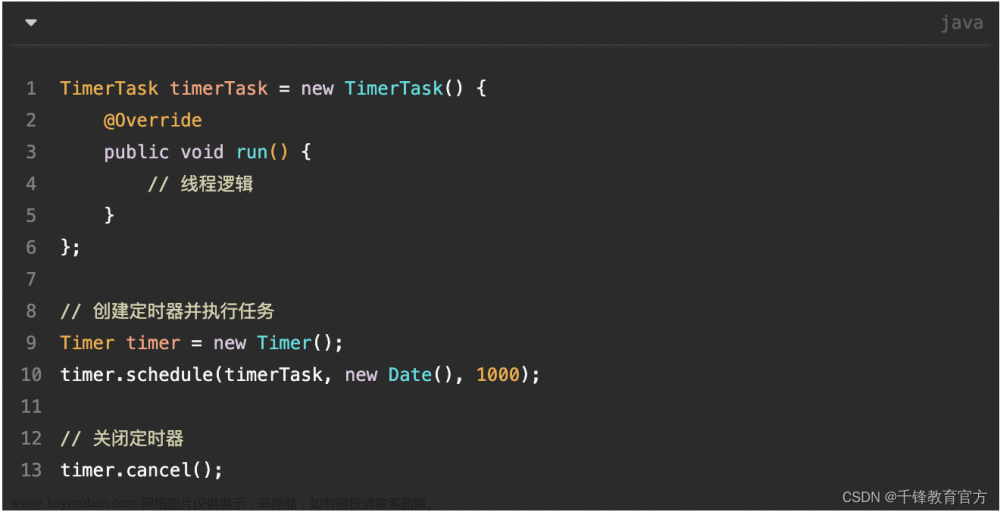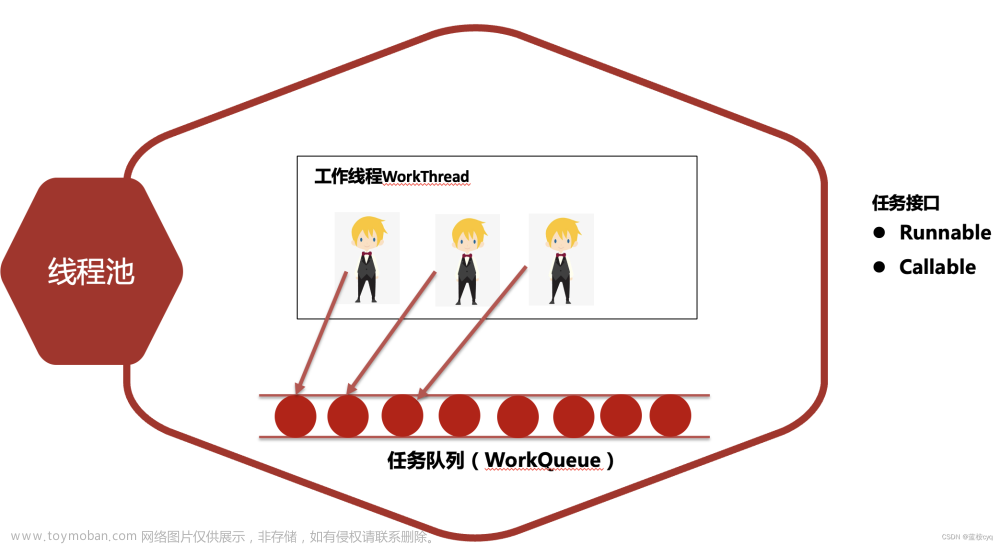1. 自定义线程池
1.1 示例代码
/**
* 自定义线程池
* <p>
* 优点:可以自定义参数
* </p>
*/
@Test
public void newThreadPoolExecutor() {
ThreadPoolExecutor executor = new ThreadPoolExecutor(
// 核心线程数
3,
// 最大线程数
5,
// 空闲线程最大存活时间
60L,
// 空闲线程最大存活时间单位
TimeUnit.SECONDS,
// 等待队列及大小
new ArrayBlockingQueue<>(100),
// 创建新线程时使用的工厂
Executors.defaultThreadFactory(),
// 当线程池达到最大时的处理策略
// new ThreadPoolExecutor.AbortPolicy() // 抛出RejectedExecutionHandler异常
new ThreadPoolExecutor.CallerRunsPolicy() // 交由调用者的线程执行
// new ThreadPoolExecutor.DiscardOldestPolicy() // 丢掉最早未处理的任务
// new ThreadPoolExecutor.DiscardPolicy() // 丢掉新提交的任务
);
// 总共5个任务
for (int i = 1; i <= 5; i++) {
int taskIndex = i;
executor.execute(() -> {
log.info("线程 " + Thread.currentThread().getName() + " 正在执行任务 " + taskIndex);
// 每个任务耗时1秒
try {
TimeUnit.SECONDS.sleep(1);
} catch (InterruptedException e) {
e.printStackTrace();
}
});
}
executor.shutdown();
}
控制台打印:
20:09:50.032 [pool-1-thread-1] INFO com.c3stones.test.ThreadPoolTest - 线程 pool-1-thread-1 正在执行任务 1
20:09:50.032 [pool-1-thread-2] INFO com.c3stones.test.ThreadPoolTest - 线程 pool-1-thread-2 正在执行任务 2
20:09:50.032 [pool-1-thread-3] INFO com.c3stones.test.ThreadPoolTest - 线程 pool-1-thread-3 正在执行任务 3
20:09:51.038 [pool-1-thread-2] INFO com.c3stones.test.ThreadPoolTest - 线程 pool-1-thread-2 正在执行任务 5
20:09:51.038 [pool-1-thread-3] INFO com.c3stones.test.ThreadPoolTest - 线程 pool-1-thread-3 正在执行任务 4
2. 固定长度线程池
2.1 示例代码
/**
* 固定大小线程池
* <p>
* 优点:当任务执行较快,且任务较少时使用方便
* </p>
* <p>
* 风险:当处理较慢时,等待队列的任务堆积会导致OOM
* </p>
*/
@Test
public void newFixThreadPool() {
// 3个固定线程
ExecutorService executorService = Executors.newFixedThreadPool(3);
// 总共5个任务
for (int i = 1; i <= 5; i++) {
int taskIndex = i;
executorService.execute(() -> {
log.info("线程 " + Thread.currentThread().getName() + " 正在执行任务 " + taskIndex);
// 每个任务耗时1秒
try {
TimeUnit.SECONDS.sleep(1);
} catch (InterruptedException e) {
e.printStackTrace();
}
});
}
executorService.shutdown();
}
控制台打印:
20:16:27.040 [pool-1-thread-2] INFO com.c3stones.test.ThreadPoolTest - 线程 pool-1-thread-2 正在执行任务 2
20:16:27.040 [pool-1-thread-3] INFO com.c3stones.test.ThreadPoolTest - 线程 pool-1-thread-3 正在执行任务 3
20:16:27.040 [pool-1-thread-1] INFO com.c3stones.test.ThreadPoolTest - 线程 pool-1-thread-1 正在执行任务 1
20:16:28.048 [pool-1-thread-3] INFO com.c3stones.test.ThreadPoolTest - 线程 pool-1-thread-3 正在执行任务 4
20:16:28.048 [pool-1-thread-2] INFO com.c3stones.test.ThreadPoolTest - 线程 pool-1-thread-2 正在执行任务 5
前3个任务被同时执行,因为刚好有3个核心线程。后2个任务会被存放到阻塞队列,当执行前3个任务的某个线程空闲时会从队列中获取任务并执行。
2.2 源码剖析
/**
* Creates a thread pool that reuses a fixed number of threads
* operating off a shared unbounded queue. At any point, at most
* {@code nThreads} threads will be active processing tasks.
* If additional tasks are submitted when all threads are active,
* they will wait in the queue until a thread is available.
* If any thread terminates due to a failure during execution
* prior to shutdown, a new one will take its place if needed to
* execute subsequent tasks. The threads in the pool will exist
* until it is explicitly {@link ExecutorService#shutdown shutdown}.
*
* @param nThreads the number of threads in the pool
* @return the newly created thread pool
* @throws IllegalArgumentException if {@code nThreads <= 0}
*/
public static ExecutorService newFixedThreadPool(int nThreads) {
return new ThreadPoolExecutor(nThreads, nThreads,
0L, TimeUnit.MILLISECONDS,
new LinkedBlockingQueue<Runnable>());
}
该类型线程池的核心线程数和最大线程数为指定的参数,空闲线程的存活线程时间为0毫秒,等待队列使用LinkedBlockingQueue,初始化大小为Integer.MAX_VALUE(即:2147483647)。
当任务执行较慢时,阻塞队列存有大量的任务等待,这些任务会占用大量的内存,从而可能导致OOM。
3. 单一线程池
3.1 示例代码
/**
* 单一线程池
* <p>
* 优势:保存任务按照提交的顺序执行
* </p>
* <p>
* 风险:当处理较慢时,等待队列的任务堆积会导致OOM
* </p>
*/
@Test
public void newSingleThreadExecutor() {
// 1个线程
ExecutorService executor = Executors.newSingleThreadExecutor();
// 总共5个任务
for (int i = 1; i <= 5; i++) {
int taskIndex = i;
executor.execute(() -> {
log.info("线程 " + Thread.currentThread().getName() + " 正在执行任务 " + taskIndex);
// 每个任务耗时1秒
try {
TimeUnit.SECONDS.sleep(1);
} catch (InterruptedException e) {
e.printStackTrace();
}
});
}
executor.shutdown();
}
控制台打印:
20:31:04.970 [pool-1-thread-1] INFO com.c3stones.test.ThreadPoolTest - 线程 pool-1-thread-1 正在执行任务 1
20:31:05.974 [pool-1-thread-1] INFO com.c3stones.test.ThreadPoolTest - 线程 pool-1-thread-1 正在执行任务 2
20:31:06.974 [pool-1-thread-1] INFO com.c3stones.test.ThreadPoolTest - 线程 pool-1-thread-1 正在执行任务 3
20:31:07.975 [pool-1-thread-1] INFO com.c3stones.test.ThreadPoolTest - 线程 pool-1-thread-1 正在执行任务 4
20:31:08.976 [pool-1-thread-1] INFO com.c3stones.test.ThreadPoolTest - 线程 pool-1-thread-1 正在执行任务 5
所有任务按照提交的顺序执行。
3.2 源码剖析
/**
* Creates an Executor that uses a single worker thread operating
* off an unbounded queue. (Note however that if this single
* thread terminates due to a failure during execution prior to
* shutdown, a new one will take its place if needed to execute
* subsequent tasks.) Tasks are guaranteed to execute
* sequentially, and no more than one task will be active at any
* given time. Unlike the otherwise equivalent
* {@code newFixedThreadPool(1)} the returned executor is
* guaranteed not to be reconfigurable to use additional threads.
*
* @return the newly created single-threaded Executor
*/
public static ExecutorService newSingleThreadExecutor() {
return new FinalizableDelegatedExecutorService
(new ThreadPoolExecutor(1, 1,
0L, TimeUnit.MILLISECONDS,
new LinkedBlockingQueue<Runnable>()));
}
该类型线程池的核心线程数和最大线程数都为1,空闲线程的存活线程时间为0毫秒,等待队列使用LinkedBlockingQueue,初始化大小为Integer.MAX_VALUE(即:2147483647)。
当任务执行较慢时,阻塞队列存有大量的任务等待,这些任务会占用大量的内存,从而可能导致OOM。
4. 共享线程池
4.1 示例代码
/**
* 共享线程池
* <p>
* 优势:当在某一时间段内任务较多,且执行较快时方便使用
* </p>
* <p>
* 风险:当处理较慢时,会创建大量的线程
* </p>
*/
@Test
public void newCachedThreadPool() {
ExecutorService executor = Executors.newCachedThreadPool();
// 总共5个任务
for (int i = 1; i <= 5; i++) {
int taskIndex = i;
executor.execute(() -> {
log.info("线程 " + Thread.currentThread().getName() + " 正在执行任务 " + taskIndex);
// 每个任务耗时1秒
try {
TimeUnit.SECONDS.sleep(1);
} catch (InterruptedException e) {
e.printStackTrace();
}
});
}
executor.shutdown();
}
控制台打印:
20:45:31.351 [pool-1-thread-4] INFO com.c3stones.test.ThreadPoolTest - 线程 pool-1-thread-4 正在执行任务 4
20:45:31.351 [pool-1-thread-1] INFO com.c3stones.test.ThreadPoolTest - 线程 pool-1-thread-1 正在执行任务 1
20:45:31.351 [pool-1-thread-5] INFO com.c3stones.test.ThreadPoolTest - 线程 pool-1-thread-5 正在执行任务 5
20:45:31.358 [pool-1-thread-2] INFO com.c3stones.test.ThreadPoolTest - 线程 pool-1-thread-2 正在执行任务 2
20:45:31.359 [pool-1-thread-3] INFO com.c3stones.test.ThreadPoolTest - 线程 pool-1-thread-3 正在执行任务 3
每一个任务都创建了新的线程。
4.2 源码剖析
/**
* Creates a thread pool that creates new threads as needed, but
* will reuse previously constructed threads when they are
* available. These pools will typically improve the performance
* of programs that execute many short-lived asynchronous tasks.
* Calls to {@code execute} will reuse previously constructed
* threads if available. If no existing thread is available, a new
* thread will be created and added to the pool. Threads that have
* not been used for sixty seconds are terminated and removed from
* the cache. Thus, a pool that remains idle for long enough will
* not consume any resources. Note that pools with similar
* properties but different details (for example, timeout parameters)
* may be created using {@link ThreadPoolExecutor} constructors.
*
* @return the newly created thread pool
*/
public static ExecutorService newCachedThreadPool() {
return new ThreadPoolExecutor(0, Integer.MAX_VALUE,
60L, TimeUnit.SECONDS,
new SynchronousQueue<Runnable>());
}
该类型线程池的核心线程数为0,最大线程数为Integer.MAX_VALUE(即:2147483647),空闲线程最大存活时间为60秒,等待队列使用SynchronousQueue,该队列不存储数据,只做转发,具体可参考:【并发编程】Java 阻塞队列。
当任务较多或执行较慢时,会创建大量的线程,从而导致OOM。
5. 定时线程池
5.1 示例代码
/**
* 定时线程池
* <p>
* 优点:可以定时执行某些任务
* </p>
* <p>
* 风险:当处理较慢时,等待队列的任务堆积会导致OOM
* </p>
*/
@Test
public void newScheduledThreadPool() {
// // 单一线程
// ExecutorService executor = Executors.newSingleThreadScheduledExecutor();
// 指定核心线程数
ScheduledExecutorService executor = Executors.newScheduledThreadPool(3);
executor.schedule(() -> {
log.info("3秒后开始执行,以后不再执行");
// 每个任务耗时1秒
try {
TimeUnit.SECONDS.sleep(1);
} catch (InterruptedException e) {
e.printStackTrace();
}
}, 3, TimeUnit.SECONDS);
//
// executor.scheduleAtFixedRate(() -> {
// log.info("3秒后开始执行,以后每2秒执行一次");
//
// // 每个任务耗时1秒
// try {
// TimeUnit.SECONDS.sleep(1);
// } catch (InterruptedException e) {
// e.printStackTrace();
// }
// }, 3, 2, TimeUnit.SECONDS);
//
// executor.scheduleWithFixedDelay(() -> {
// log.info("3秒后开始执行,以后延迟2秒执行一次");
//
// // 每个任务耗时1秒
// try {
// TimeUnit.SECONDS.sleep(1);
// } catch (InterruptedException e) {
// e.printStackTrace();
// }
// }, 3, 2, TimeUnit.SECONDS);
}
控制台打印 - 1:
21:18:46.494 [pool-1-thread-1] INFO com.c3stones.test.ThreadPoolTest - 3秒后开始执行,以后不再执行
启动后3秒开始执行,执行完成后不再继续执行。
控制台打印 - 2:
21:22:47.078 [pool-1-thread-1] INFO com.c3stones.test.ThreadPoolTest - 3秒后开始执行,以后每2秒执行一次
21:22:49.075 [pool-1-thread-1] INFO com.c3stones.test.ThreadPoolTest - 3秒后开始执行,以后每2秒执行一次
21:22:51.075 [pool-1-thread-2] INFO com.c3stones.test.ThreadPoolTest - 3秒后开始执行,以后每2秒执行一次
启动后3秒开始执行,以后每两秒执行一次。
控制台打印 - 3:
21:28:09.701 [pool-1-thread-1] INFO com.c3stones.test.ThreadPoolTest - 3秒后开始执行,以后延迟2秒执行一次
21:28:12.705 [pool-1-thread-1] INFO com.c3stones.test.ThreadPoolTest - 3秒后开始执行,以后延迟2秒执行一次
21:28:15.707 [pool-1-thread-2] INFO com.c3stones.test.ThreadPoolTest - 3秒后开始执行,以后延迟2秒执行一次
启动后3秒开始执行,以后每次执行时间为任务的耗时时间加固定的延迟时间。
假设每次任务固定延迟2秒,第一次任务在第3秒开始执行,任务耗时1秒;第二次任务将在第一次完成后2秒开始执行(即第6秒),耗时2秒;第三次任务将在第二次完成后2秒开始执行(即第10秒),依次类推。
6. SpringBoot中注入异步线程池
6.1 自定义线程配置类
import org.springframework.context.annotation.Bean;
import org.springframework.context.annotation.Configuration;
import org.springframework.core.task.TaskExecutor;
import org.springframework.scheduling.concurrent.ThreadPoolTaskExecutor;
import java.util.concurrent.ThreadPoolExecutor;
/**
* 自定义线程池配置类
*
* @author CL
*/
@Configuration
public class TaskExecutorConfig {
/**
* 自定义任务执行器
*
* @return {@link TaskExecutor}
*/
@Bean
public TaskExecutor taskExecutor() {
ThreadPoolTaskExecutor executor = new ThreadPoolTaskExecutor();
// 核心线程数,默认1
int corePoolSize = Runtime.getRuntime().availableProcessors();
executor.setCorePoolSize(corePoolSize);
// 最大线程数,默认Integer.MAX_VALUE
executor.setMaxPoolSize(corePoolSize * 2 + 1);
// 空闲线程最大存活时间,默认60秒
executor.setKeepAliveSeconds(3);
// 等待队列及大小,默认Integer.MAX_VALUE
executor.setQueueCapacity(500);
// 线程的名称前缀,默认该Bean名称简写:org.springframework.util.ClassUtils.getShortName(java.lang.Class<?>)
executor.setThreadNamePrefix("custom-thread-");
// 当线程池达到最大时的处理策略,默认抛出RejectedExecutionHandler异常
// executor.setRejectedExecutionHandler(new ThreadPoolExecutor.AbortPolicy()); // 抛出RejectedExecutionHandler异常
executor.setRejectedExecutionHandler(new ThreadPoolExecutor.CallerRunsPolicy()); // 交由调用者的线程执行
// executor.setRejectedExecutionHandler(new ThreadPoolExecutor.DiscardOldestPolicy()); // 丢掉最早未处理的任务
// executor.setRejectedExecutionHandler(new ThreadPoolExecutor.DiscardPolicy()); // 丢掉新提交的任务
// 等待所有任务结束后再关闭线程池,默认false
executor.setWaitForTasksToCompleteOnShutdown(true);
// 等待所有任务结束最长等待时间,默认0毫秒
executor.setAwaitTerminationSeconds(10);
// 执行初始化
executor.initialize();
return executor;
}
}
- 在Service注入使用
/**
* 示例Service
*
* @author CL
*/
public interface DemoService {
/**
* 示例方法
*
* @return {@link String}
*/
void demo();
}
import lombok.extern.slf4j.Slf4j;
import org.springframework.core.task.TaskExecutor;
import org.springframework.stereotype.Service;
import javax.annotation.Resource;
/**
* 示例Service实现
*
* @author CL
*/
@Slf4j
@Service
public class DemoServiceImpl implements DemoService {
@Resource
private TaskExecutor taskExecutor;
/**
* 示例方法
*/
@Override
public void demo() {
taskExecutor.execute(() -> {
log.info("线程 " + Thread.currentThread().getName() + " 正在执行Service中的方法");
});
}
}
- 异步任务指定线程池
import lombok.extern.slf4j.Slf4j;
import org.springframework.scheduling.annotation.Async;
import org.springframework.scheduling.annotation.EnableAsync;
import org.springframework.stereotype.Component;
/**
* 示例异步任务
*
* @author CL
*/
@Slf4j
@Component
@EnableAsync
public class DemoAsync {
/**
* 示例方法
*/
@Async(value = "taskExecutor")
public void demo() {
log.info("线程 " + Thread.currentThread().getName() + " 正在执行Async中的方法");
}
}
- 定时任务调度指定线程池
import org.springframework.context.annotation.Bean;
import org.springframework.context.annotation.Configuration;
import org.springframework.scheduling.TaskScheduler;
import org.springframework.scheduling.annotation.SchedulingConfigurer;
import org.springframework.scheduling.concurrent.ThreadPoolTaskScheduler;
import org.springframework.scheduling.config.ScheduledTaskRegistrar;
import java.util.concurrent.Executors;
import java.util.concurrent.ScheduledExecutorService;
import java.util.concurrent.ThreadPoolExecutor;
/**
* 自定义定时任务调度配置类
*
* @author CL
*/
@Configuration
public class SheduledConfig implements SchedulingConfigurer {
/**
* 配置定时任务
*
* @param scheduledTaskRegistrar 配置任务注册器
*/
@Override
public void configureTasks(ScheduledTaskRegistrar scheduledTaskRegistrar) {
scheduledTaskRegistrar.setScheduler(taskScheduler());
// // 第二种方式
// scheduledTaskRegistrar.setScheduler(scheduledExecutorService());
}
/**
* 自定义任务调度器
*
* @return {@link TaskScheduler}
*/
@Bean
public TaskScheduler taskScheduler() {
ThreadPoolTaskScheduler executor = new ThreadPoolTaskScheduler();
executor.setPoolSize(5);
executor.setThreadNamePrefix("custom-scheduler-");
executor.setRejectedExecutionHandler(new ThreadPoolExecutor.CallerRunsPolicy());
executor.initialize();
return executor;
}
// /**
// * 自定义任务线程池
// *
// * @return {@link ScheduledExecutorService}
// */
// @Bean
// public ScheduledExecutorService scheduledExecutorService() {
// return Executors.newScheduledThreadPool(5);
// }
}
6.2 测试
- 编写测试Controller
import com.c3tones.async.DemoAsync;
import com.c3tones.service.DemoService;
import lombok.extern.slf4j.Slf4j;
import org.springframework.web.bind.annotation.RequestMapping;
import org.springframework.web.bind.annotation.RestController;
import javax.annotation.Resource;
/**
* 示例Controller
*
* @author CL
*/
@Slf4j
@RestController
public class DemoController {
@Resource
private DemoService demoService;
@Resource
private DemoAsync demoAsync;
/**
* Service示例方法
*
* @return {@link String}
*/
@RequestMapping("/service")
public void service() {
log.info("Service示例方法开始执行");
demoService.demo();
log.info("Service示例方法结束执行");
}
/**
* 异步示例方法
*
* @return {@link String}
*/
@RequestMapping("/async")
public void async() {
log.info("异步示例方法开始执行");
demoAsync.demo();
log.info("异步示例方法结束执行");
}
}
- 启动项目
- 测试Service中的自定义线程池
curl http://127.0.0.1:8080/service
控制台打印:
2023-03-19 22:26:26.896 INFO 136568 --- [nio-8080-exec-3] com.c3tones.controller.DemoController : Service示例方法开始执行
2023-03-19 22:26:26.897 INFO 136568 --- [nio-8080-exec-3] com.c3tones.controller.DemoController : Service示例方法结束执行
2023-03-19 22:26:26.897 INFO 136568 --- [custom-thread-1] com.c3tones.service.DemoServiceImpl : 线程 custom-thread-1 正在执行Service中的方法
调用接口同步打印日志,自定义线程异步执行任务。
- 测试异步任务中的自定义线程池
curl http://127.0.0.1:8080/async
控制台打印:
2023-03-19 22:28:08.349 INFO 136568 --- [nio-8080-exec-7] com.c3tones.controller.DemoController : 异步示例方法开始执行
2023-03-19 22:28:08.355 INFO 136568 --- [nio-8080-exec-7] com.c3tones.controller.DemoController : 异步示例方法结束执行
2023-03-19 22:28:08.363 INFO 136568 --- [custom-thread-2] com.c3tones.async.DemoAsync : 线程 custom-thread-2 正在执行Async中的方法
调用接口同步打印日志,异步线程异步执行任务。文章来源:https://www.toymoban.com/news/detail-596679.html
- 测试定时任务中的自定义线程池
- 编写测试方法
import lombok.extern.slf4j.Slf4j; import org.springframework.scheduling.annotation.EnableScheduling; import org.springframework.scheduling.annotation.Scheduled; import org.springframework.stereotype.Component; /** * 示例定时任务 * * @author CL */ @Slf4j @Component @EnableScheduling public class DemoScheduled { /** * 示例方法 */ @Scheduled(cron = "0/3 * * * * ? ") public void demo() { log.info("线程 " + Thread.currentThread().getName() + " 正在执行Scheduled中的方法"); } }- 启动服务
控制台打印:
定时任务从0秒开始,每3秒执行一次任务。2023-03-19 22:30:24.002 INFO 136568 --- [tom-scheduler-3] com.c3tones.sheduled.DemoScheduled : 线程 custom-scheduler-3 正在执行Scheduled中的方法 2023-03-19 22:30:27.002 INFO 136568 --- [tom-scheduler-3] com.c3tones.sheduled.DemoScheduled : 线程 custom-scheduler-3 正在执行Scheduled中的方法 2023-03-19 22:30:30.001 INFO 136568 --- [tom-scheduler-3] com.c3tones.sheduled.DemoScheduled : 线程 custom-scheduler-3 正在执行Scheduled中的方法
7. 项目地址
thread-demo文章来源地址https://www.toymoban.com/news/detail-596679.html
到了这里,关于【并发编程】SpringBoot创建线程池的六种方式的文章就介绍完了。如果您还想了解更多内容,请在右上角搜索TOY模板网以前的文章或继续浏览下面的相关文章,希望大家以后多多支持TOY模板网!











